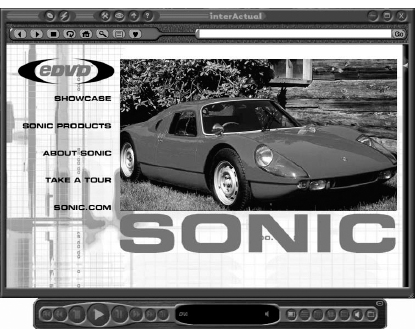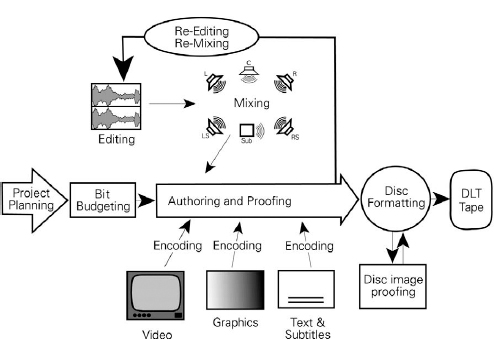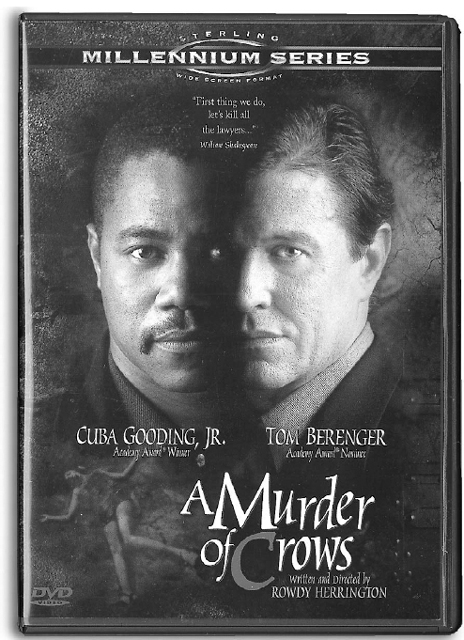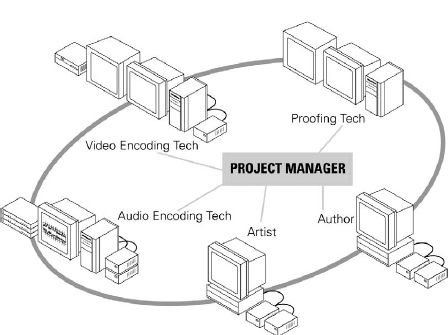So far, we’ve covered the steps in the DVD production process, but we haven’t really looked at how those steps are most effectively accomplished. It won’t help much to fall back on workflow models from existing video and audio formats. Traditionally, even in delivery media where sound and picture are presented together (film, television, home video), the production work on audio is mostly handled separately from work on the picture, with integration into a single medium taking place at the final stages. The two crafts have developed in parallel but independently, with little sharing of resources, standards, operating procedures, or personnel.
This approach seems to work well in film and television, and it may also be fine for the upstream production work often involved in making a DVD, such as shooting and editing a video featurette, or recording audio commentary tracks. But the fact that DVD-Video and DVD-Audio are integrated formats, where every element on a disc potentially influences every other (remember the Bit-Budget™), argues strongly for an integrated workflow where every element is easily accessible at every production stage. Collections of inflexible single-purpose ‘black boxes’ – first-generation DVD tools with little potential for central control or information sharing – are ill-adapted to the demands of an integrated process, and will lead to bottlenecks and inefficiencies.
Integrated production environment
The alternative to the first-generation approach is an integrated production environment. The incorporation of asset preparation, authoring, proofing and imaging all into a unified environment removes barriers to the iterative cycle of proofing and revision, on which quality title production depends. Elements can be easily imported – and updated elements re-imported – directly from files created by asset preparation tools in the same system, without time-consuming transfers. An integrated environment also enables a system such as AutoSonic™ to batch-encode source assets directly from their stored locations throughout a production network.
Because DVD and its associated technologies have applications in so many different areas, there is no one ‘right’ way to set up an integrated production facility. Within the integrated work model, there are several main variants: the all-in-one, standalone workstation, an integrated NLE/DVD publishing environment, and a multi-user networked workgroup.
Questions to ask
Before deciding which approach to DVD production makes the most sense for your situation, it is important to define the type of work you expect to accomplish, and under what conditions. Once again, thinking through the answers to a set of questions is a good way to start.
Figure 9.1 Workflow of an integrated DVD production environment.
In what areas will your DVD activities be concentrated?
With versatility being one of the defining attributes of DVD, it is no surprise that applications for the format may be found in many different fields, including film, music, advertising, video post, corporate communications, and multimedia gaming. But while DVDs are used in all these areas, a feature film title for home video is quite different from a title for a museum kiosk. These differences are reflected in the different ways that production of titles in various fields is organized. To optimize your workflow, it is very important to start with a clear idea of the types of clients you expect to serve, or – if the ‘client’ happens to be you or others within your own organization – what category of client you fall into.
Home video and recorded music
One of the main distinctions between the different types of markets in which DVD is used is whether the titles are mass-produced for commercial distribution to consumers or used for internal purposes. The clearest example of the former is currently the home video market, but many of the same workflow considerations may be expected to apply to producing music titles when DVD-Audio is available.
The commercial realities of these market segments dictate a workflow designed to output titles with both the highest-possible production values (video and audio fidelity) and the highest-possible throughput. Optimal productivity is achieved in networked, multi-user settings that allow production to proceed in parallel, with operators concentrating on creative work while automated processing tasks are handled in the background.
Video post, advertising, and independent production
DVD’s utility for delivery of video content goes beyond just the home video market. For showing a portfolio or pitching a concept, the format offers an attractive combination of high quality and random-access convenience. Video post-production houses, for instance, are finding that many clients are attracted to DVD as a medium for obtaining approvals, delivering programs to reviewers, and other limited-run distribution tasks currently handled by VHS dubs. The same is true for independent producers, for whom DVD publishing is a new service to offer to clients. In advertising, meanwhile, DVD is becoming the preferred source for viewing video content, and video producers working in advertising are finding that it is rapidly becoming critical to be able to publish on DVD.
In these video-centric industries, where DVD production is not the main focus, the addition of DVD capabilities is most efficient when systems are designed to fit seamlessly with the existing production workflow. For instance, when DVD functionality is integrated with the NLE systems commonly used for editing in video post houses and ad agencies, edited video files may be transcoded directly to MPEG-2 video, without first being transferred to tape for capture/encoding.
Corporate and institutional
Corporate AV departments are finding numerous uses for DVD, including presentations, trade-show displays, employee and/or customer training, and point-of-sale kiosks. Similar applications are found at museums, libraries and educational institutions.
The source materials used in these fields is diverse. If the primary focus is on video, an NLE system may already be present, and an approach similar to the video post workflow may work well. On the other hand, many projects are more multimedia oriented, with quizzes, several languages and web links in addition to multiple video clips. Such titles often involve greater interactive complexity than linear video presentations, and the organization of production may well reflect an emphasis on flexibility and customization rather than standardization and throughput.
Multimedia publishing
The diversity and interactivity found in much corporate DVD work also applies to commercially published multimedia DVD, which ranges from games to reference and information titles. The workflow may be similar to that found at developers of multimedia CD-ROM, but with tools supporting the DVD specification and optimized for DVD media types and navigation.
Videographers and enthusiasts
With DVD player penetration growing rapidly in consumer households, the format is becoming increasingly attractive as a video delivery medium for both professional event videographers and video enthusiasts. This trend will likely accelerate with the proliferation of Digital Video camcorders, the enhanced video-handling capabilities of personal computers, and the improved capacity and compatibility of inexpensive, writeable DVD formats such as DVD-RAM, DVD-R, and DVD+RW.
While consumers will want to see events in their own lives – weddings, anniversaries, birthday parties – on Hollywood-like DVDs, it is unlikely the demand will be high for complex interactivity. Thus the highest priorities in DVD publishing for this market will likely be simplicity and fast turnaround.
What are the typical types of DVD titles to be produced for your target market?
DVD’s versatility allows for a great diversity of title types, and new genres of DVD are likely to emerge as the format matures. Most titles, however, fall into one of several general categories described below. It is important to keep in mind while planning your facility which of these types of DVDs your clients will be asking you to make, and what is involved in making them. Remember as well that any title in the DVD-Video or DVD-Audio format may include additional information or capabilities – a database, computer game or Web connection, for instance – that are available to the user when the disc is played from a computer-hosted DVD-ROM drive.
Feature-length DVD movies
These titles typically contain more than 60 minutes of video material, generally one main program with perhaps one or more associated ‘featurettes.’ For instance, a 90-minute feature film might be accompanied by a 20-minute ‘The Making of…’ short subject. The emphasis is normally on linear presentation of the video programs, with minimal navigational options within each program. Designed for playback on DVD-Video set-top players, such titles must be compliant with the DVD-Video specification. Because of the length of the video material, VBR encoding capability will be required.
At the premium end of the home video market, movie titles now commonly include additional value-added features such as immersive 3D menus, side-by-side comparison of storyboards with finished scenes, or links between the shooting script and the feature presentation. When played in DVD-ROM drives, these titles often include direct links to a promotional Web site which includes merchandising and special activities such as contests. Thus, title production for home video is a considerably more complex field today than it was just two years ago.
Figure 9.2 A feature film DVD-Video title. (Images courtesy of Sterling Home Entertainment, LLC. Copyright © 2000 by Sterling Home Entertainment, LLC)
DVD-Audio music albums
As we saw earlier, DVD-Audio is a very flexible format that allows for inclusion of a wide variety of extra media such as slide shows, lyrics, music videos, and documentary video. As with home video titles, DVD-Audio releases will probably also be Web-connected, linking fans to the band or label site for tour information, contests and merchandise.
As of this writing, it is too early to say exactly how producers and record labels will choose to use DVD-Audio’s capabilities, and what consumers will expect. We do know, however, that a DVD-Audio production facility will need, at a minimum, the capability to enhance and prepare high-resolution audio formats in both stereo and multichannel configurations. Beyond that, audio mastering facilities may choose to hand off the multimedia aspects of their projects to existing facilities that also handle DVD-Video, or they may take the opportunity to extend their own reach into new markets.
Music video and karaoke
While DVD-Audio is new, music applications of DVD-Video are not. The existence of many successful ‘in concert’ music video titles, as well as DVD’s ideal characteristics for both music video compilations and karaoke, mean that music is often cited as the second most popular category of commercially available DVD-Video titles (after feature films).
Audio quality is clearly a priority in music DVD-Video titles, which may take advantage of the format’s PCM capabilities to deliver CD-quality (or better) sound. Except for concert videos, music video and karaoke titles will normally contain multiple short video clips. In addition to menu-based navigation, such titles may also be authored automatically to play through the clips, like tracks on an audio CD. Karaoke titles will include at least two audio streams: one with lead vocals and another without, and may take advantage of the multiple ‘karaoke down-mix’ modes within the Dolby Digital format.
Presentations and kiosks
The availability of both industrial DVD-Video players and DVD-enabled laptops has made DVD the ideal medium for many corporate and institutional multimedia presentations formerly delivered on LaserDisc, videotape or directly from the hard drive of a laptop computer. DVD is perfect for integrated presentations combining bullet points with top-quality video, and the format’s navigational capabilities allow presentations to be easily tailored on-the-fly for a given audience. With a DVD laptop, nontechnical executive or sales personnel can deliver such presentations in any venue, from a shareholder’s meeting to a one-on-one with an important client.
Figure 9.3 An information-gathering screen from a DVD-Video based kiosk. (Courtesy of Zuma Digital)
Using an industrial player, DVD-Video content may be synchronized with lighting, live sound and other presentation media for a tightly-integrated production. At the same time, industrial players allow unattended playback to be scheduled at predetermined times in settings such as trade shows, museums and point-of-purchase. Industrial players are also well suited for touch-screen-based kiosks with applications in museums, retailing and public facilities.
Interactive DVD
Titles that make extensive use of the interactive capabilities of DVD (primarily DVD-Video) may range from learning titles (education and training) to games. In general, titles will be structured to take advantage of the format’s strengths (image and sound quality), using multiple short video and audio clips with a navigational structure that involves the end user in determining the order of playback, either directly through menus or on-the-fly through user input during playback.
The DVD-Video specification provides General parameter locations for the storing of user responses, allowing conditional navigation based, for instance, on keeping track of a user’s score in a game. However, title design will have to take into account that memory is limited compared to PC-based interactive platforms, and that playback performance is not optimized for action games.
The navigational complexity of interactive titles accentuates the importance of authoring in the title preparation process, and places increased demands on the project planning, interface design, proofing and quality control phases of production. Many interactive titles will probably take advantage of DVD-Video’s ability to switch seamlessly between multiple angles at playback, thereby adding to the video material to be captured and stored on the disc, and increasing the likelihood of VBR encoding.
Pure DVD-ROM
While the title types above may be hybrids that include DVD-ROM information in the DVD-Others zone, they are designed primarily for playback on set-top DVD players. A pure DVD-ROM title has no DVD-Video or DVD-Audio zone, and thus will play only on a computer-hosted DVD-ROM drive. These titles typically deliver much the same information as found on CD-ROM, but take advantage of DVD’s massive capacity. DVD-ROM data may include text and word processing documents, database and spreadsheet files, multimedia presentations, digital audio, graphics and video, HTML pages, and browsers supporting Web connectivity.
Web-connected hybrid (eDVD™)
With eDVD™, the DVD-Video content on a title is enhanced by integrating it into a Web-connected browser when it is played on a DVD-ROM equipped computer. DVD titles in many of the categories above – feature film, music, corporate, gaming – can benefit greatly from the addition of Web connectivity. Links to the Web may be used to enable commerce and merchandising, provide documentation and updated information, facilitate individualized learning or training, and draw users into chats, contests and other ‘community’ activities.
In addition to the general production considerations involved with a title in a given category, adding Web connectivity will normally involve the close coordination of production efforts for the DVD-Video material and the Web material. Web design expertise (in-house or outsourced) will likely be necessary to ensure effective integration of these two mediums.

Figure 9.4 Sonic’s eDVD is an example of Web-connected DVD technology Using industry-standard Interactual technology, eDVD discs are compatible with all DVD players.
In addition to these general categories of DVD projects, you may find clients that are involved in non-DVD activities which use some of the same production technologies. Specifically, an investment in a video encoding system such as that included in Sonic DVD Creator may enable your facility to serve clients involved in broadcast, video-on-demand and other applications of MPEG encoding.
What audio formats are typically used on the type of DVDs your clients will be releasing?
As we have seen above, the DVD-Video and DVD-Audio specifications support a wide variety of audio formats, including PCM (at a wide range of sample rates and word lengths), Dolby Digital and MPEG. A flexible palette of channel configurations (mono through multichannel surround) is also supported, as are optional additional formats such as DTS. This potentially adds up to a very complex audio production situation, particularly for DVD-Video, where up to eight parallel audio streams may be used in a single title set.
In actual practice, the type of audio used will vary depending on the type of title. A facility designed to produce feature-length DVDs will likely need to be able to provide surround-sound encoding in Dolby Digital and MPEG formats, depending on the release region. For DVD-Audio titles, high-resolution multichannel pre-mastering capabilities will be expected, while for music video and karaoke DVD-Videos, CD-quality stereo PCM audio may be sufficient.
What is your expected volume of work?
Depending on your assessment of the needs of your market, you may be planning to develop your DVD facility gradually, or to jump right into full-scale production. Your anticipated volume of work will determine your need for throughput, which greatly influences the architecture of your production system.
High volume production – more than 20 to 30 titles per year – generally demands a workflow that is collaborative and parallel rather than separate and sequential. Workgroup throughput may be maximized with the incorporation of batch encoding capabilities, allowing more efficient allocation of facility resources.
In a workgroup environment, the number of discrete workstations you design into your system will determine the specific capabilities you assign to each station. However, even if your current volume or budget dictate a single-station solution, an integrated environment of modular, upgradable components allows you to tailor a system to your current needs without limiting your ability to grow as business expands.
What are your company’s existing areas of expertise, and in what areas do additional skills need to be developed?
DVD production is not really a single discipline, but rather a process that integrates existing fields such as video post-production, audio engineering, graphic design and multimedia authoring. As with any service business, your clients will come to you not simply for the equipment you own but for the skill with which you use it.
If your business is already involved in media production, you can bring to DVD the expertise particular to your areas of specialization. Because the format is new, however, and its requirements so broad, you may well find areas where the collective knowledge base of your staff needs strengthening to operate your DVD facility effectively. Options include hiring additional staff with the required skills, or re-purposing existing staff via training courses and hands-on experience with the production system.
The pace at which a given facility extends its expertise into new areas depends, once again, on who its clients are and what services they need. If history is any guide, however, there is no time like the present to begin developing skills for the next generation of technology. In home video, for instance, the volume of production skyrocketed after DVD’s consumer appeal was confirmed by a strong launch. Post production houses that took DVD seriously early on have naturally been well positioned to capitalize on the current boom, while others have been struggling to catch up. Similarly, mastering houses that embraced CD-Audio thrived during the re-issue boom that followed the format’s popularization, while those that saw mastering only in terms of phonograph records, did not survive the transition.
Listed below are the functions that will need to be covered by a DVD production facility staff. In a large facility, each function may be a separate position. In a smaller operation, individual operators may need to cover multiple tasks. In a multi-station workgroup configuration, one individual may be able to set up and start a process at one station (video encoding, for instance) and then move to a different station to continue work on a different aspect of production.
Figure 9.5 Typical division of labour in a DVD production workgroup.
Producer
The producer may be the client, a third party hired by the client, or someone on-staff at the DVD facility. Whatever the case, the producer is ultimately responsible for the end-product of the DVD production process. Responsibilities include defining the content, functionality and feel of the title in the project planning phase, as well as overseeing production, hiring talent, and choosing other members of the production team. A strong overall understanding of the capabilities and limitations of DVD, as well as the production process, is more important than hands-on skills in any particular area.
Project manager
The project manager is responsible for scheduling workflow and milestones, the timely execution of production and the completion of projects within budget. A thorough understanding is required of each step in the DVD preparation process, as well as the relationship between steps. An efficient project manager should be able efficiently to manage multiple complex productions, including working with clients to define expectations, tracking the progress of diverse production elements, and coordinating parallel processes.
Graphic designer
By defining the ‘look and feel’ of the graphic design, the artist sets the tone for the user’s experience of the title. Graphics play a role not only as content but also in navigation. The artist thus needs both expertise in computer-based graphic production techniques and a thorough understanding of userinterface design. In addition, knowledge of design issues specific to both NTSC and PAL television is helpful, including awareness of aspect ratios, safe areas and colour ranges.
Author
The author integrates all content elements and builds a title’s navigational structure. Responsibilities include defining menu ‘hot spots’ and programing button links, as well as proofing to ensure compliance with the approved title design. Effective authoring depends not only on familiarity with media integration and interactive navigation design, but also on a thorough knowledge of common file formats for media assets. The advanced author will also be able to program register usage for score-keeping or conditional branching, and to integrate DVD-Video or DVD-Audio content with Web applications and other materials stored in the DVD-Others zone.
Video encoding technician
The video encoder can have a substantial impact on the quality of video encoding, particularly if the source material requires pre-processing, filtering or manual editing. The ideal background for this position is previous experience with digital video compression systems or in video production. For feature film releases, it may take 3 to 6 months of hands-on work with the encoding system to develop advanced skills in manipulating MPEG compression variables, which are needed for optimal results. For corporate applications, experience with Avid or Media 100 NLV editing systems will typically provide the required expertise.
Audio pre-mastering engineer
Mastering engineers with extensive experience in preparing material for CD-Audio release have the required foundation of critical listening and sound enhancement skills for DVD-Audio, including level matching, EQ, dynamics processing, and editing. However, the range of options in DVD-Audio titles make them potentially far more complex than CDs, and it may take pre-mastering engineers a while to adapt their techniques to the new possibilities.
Audio encoding technician
Basic understanding of audio formats, interfacing and production is required, but the crucial attributes for an audio encoder are a good ear and a sense – which may have to be developed on the job – of how surround-sound formats should sound when properly encoded. Ideally, the audio encoder will also know how to adjust Dolby Digital encoding parameters.




